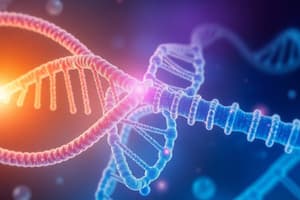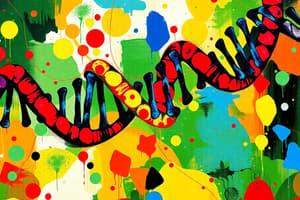Podcast
Questions and Answers
What is the primary phase of bacterial growth characterized by rapid division and increase in number?
What is the primary phase of bacterial growth characterized by rapid division and increase in number?
- Death phase
- Exponential phase (correct)
- Stationary phase
- Lag phase
Biofilms are biological communities that provide no significant advantage to bacteria.
Biofilms are biological communities that provide no significant advantage to bacteria.
False (B)
What is the process of using chemicals to reduce pathogen levels on surfaces known as?
What is the process of using chemicals to reduce pathogen levels on surfaces known as?
Disinfection
The __________ phase of bacterial growth is characterized by nutrient depletion and waste accumulation.
The __________ phase of bacterial growth is characterized by nutrient depletion and waste accumulation.
Match the following chemical agents with their mechanism of action:
Match the following chemical agents with their mechanism of action:
Which of the following statements about the Lac operon is true?
Which of the following statements about the Lac operon is true?
Sister chromatids are identical copies of a chromosome held together by a centromere.
Sister chromatids are identical copies of a chromosome held together by a centromere.
What are the main roles of mRNA, rRNA, and tRNA in the process of translation?
What are the main roles of mRNA, rRNA, and tRNA in the process of translation?
In bacteria, ________ is the process of genetic material transfer through direct cell contact.
In bacteria, ________ is the process of genetic material transfer through direct cell contact.
Match the following phases of mitosis with their descriptions:
Match the following phases of mitosis with their descriptions:
Which of the following is a macronutrient required by microorganisms?
Which of the following is a macronutrient required by microorganisms?
All forms of oxygen are toxic to bacteria.
All forms of oxygen are toxic to bacteria.
What is the significance of cell cycle checkpoints?
What is the significance of cell cycle checkpoints?
Flashcards are hidden until you start studying
Study Notes
DNA Replication
- Steps:
- Initiation: DNA polymerase binds to origin of replication.
- Elongation: DNA polymerase adds new nucleotides to the growing DNA strand.
- Termination: Replication is complete.
- Enzymes:
- DNA polymerase: Synthesizes new DNA strands.
- Helicase: Unwinds the DNA double helix.
- Topoisomerase: Relieves tension in the DNA molecule.
- Primase: Synthesizes RNA primers.
- Ligase: Joins the Okazaki fragments.
Transcription
- Steps:
- Initiation: RNA polymerase binds to the promoter and unwinds the DNA.
- Elongation: RNA polymerase synthesizes a complementary RNA strand.
- Termination: RNA polymerase reaches the terminator sequence and releases the RNA transcript.
- Enzymes & Factors:
- RNA polymerase: Synthesizes RNA.
- Transcription factors: Proteins that help RNA polymerase bind to the promoter.
Translation
- Steps:
- Initiation: mRNA binds to the ribosome.
- Elongation: tRNA brings amino acids to the ribosome, where they are added to the growing polypeptide chain.
- Termination: The ribosome reaches a stop codon, and the polypeptide is released.
- Genetic code:
- Codons: Three-nucleotide sequences on mRNA that specify amino acids.
- Anticodons: Three-nucleotide sequences on tRNA that are complementary to codons.
- Wobble: The ability of some tRNA anticodons to pair with more than one codon.
- RNA roles:
- mRNA: Messenger RNA, carries genetic information from DNA to ribosomes.
- rRNA: Ribosomal RNA, forms the structure of ribosomes.
- tRNA: Transfer RNA, carries amino acids to ribosomes during translation.
Bacterial Gene Regulation
- Operons: Clusters of genes that are transcribed together.
- Lac operon: An example of an inducible operon, regulated by the presence of lactose.
- In the absence of lactose: Repressor protein binds to the operator, preventing transcription of the lac genes.
- In the presence of lactose: Lactose binds to the repressor, causing it to detach from the operator, allowing transcription.
Horizontal Gene Transfer
- Methods Bacteria Use to Acquire Genetic Material:
- Conjugation: Transfer of genetic material through direct contact between bacteria.
- Transformation: Bacteria acquire DNA from the environment.
- Transduction: Transfer of genetic material via bacteriophages.
Mutations in DNA
- Types:
- Point mutations: Changes in a single nucleotide.
- Insertions/Deletions: Adding or removing nucleotides.
- Causes:
- Spontaneous mutations: Occur naturally during DNA replication.
- Induced mutations: Caused by mutagens, such as radiation or chemicals.
Chromosomes and Cell Cycle
- Chromatin: Loosely packed DNA in the nucleus.
- Chromosomes: Tightly packed DNA during cell division.
- Sister chromatids: Two identical copies of a chromosome.
- Centromere: The region where sister chromatids are joined.
- Autosomes: Chromosomes that are not sex chromosomes.
- Sex chromosomes: Determine sex (X and Y in humans).
- Karyotype: A visual representation of an organism's chromosomes.
- Telomeres: The ends of linear chromosomes.
- Telomerase: An enzyme that adds telomeres to protect the ends of chromosomes during replication.
- Cell cycle checkpoints: Ensure that the cell is ready to proceed to the next stage.
- Phases of the cell cycle:
- G1 phase: The cell grows and synthesizes proteins.
- S phase: DNA replication occurs.
- G2 phase: The cell prepares for mitosis.
- M phase: Cell division (mitosis or meiosis).
- G0 phase: A quiescent state where cells are not actively dividing.
Mitosis
- Phases:
- Prophase: Chromatin condenses into chromosomes, the nuclear envelope breaks down, and the mitotic spindle forms.
- Metaphase: Chromosomes align at the metaphase plate.
- Anaphase: Sister chromatids separate and move to opposite poles of the cell.
- Telophase: Chromosomes decondense, the nuclear envelope reforms, and the cytoplasm divides.
- Cell types that undergo mitosis: Somatic cells (non-reproductive cells).
Meiosis
- Process: Meiosis reduces the number of chromosomes in a cell by half.
- Results: Four haploid gametes (sex cells).
- Cell types that undergo meiosis: Germ cells (reproductive cells).
Microbial Nutrition and Growth
- Heterotrophs: Obtain carbon from organic sources.
- Autotrophs: Obtain carbon from inorganic sources (e.g., CO2).
- Macronutrients: Required in large amounts (e.g., carbon, nitrogen, phosphorus).
- Micronutrients: Required in small amounts (e.g., trace metals).
- Growth factors: Organic compounds that are essential for growth.
- Transport methods:
- Passive diffusion: Movement of molecules across the membrane without energy.
- Facilitated diffusion: Movement of molecules across the membrane with the help of transport proteins.
- Active transport: Movement of molecules across the membrane against their concentration gradient, requiring energy.
- Environmental factors:
- Temperature:
- Cardinal temperatures: Minimum, optimum, and maximum temperatures for growth.
- Groups by temperature range: Psychrophiles, mesophiles, thermophiles, hyperthermophiles.
- pH:
- Acidophiles: Grow at low pH.
- Alkaliphiles: Grow at high pH.
- Osmotic effects:
- Halophiles: Grow in high salt concentrations.
- Oxygen effects:
- Obligate aerobes: Require oxygen for growth.
- Facultative anaerobes: Can grow with or without oxygen.
- Obligate anaerobes: Cannot grow in the presence of oxygen.
- Aerotolerant anaerobes: Can tolerate oxygen but do not use it.
- Microaerophiles: Require low oxygen levels.
- Temperature:
- Binary fission: The process of cell division in bacteria.
- Doubling time/generation time: The time it takes for a population of bacteria to double in size.
- Bacterial growth curve:
- Lag phase: Bacteria are adjusting to their environment.
- Exponential (log) phase: Bacteria are dividing rapidly at a constant rate.
- Stationary phase: Growth slows down due to limited resources.
- Death (decline) phase: Bacteria die due to a lack of resources and accumulation of toxic waste products.
- Methods of measuring cell growth:
- Direct methods:
- Microscopic count: Counting bacteria directly under a microscope.
- Plate count: Counting colonies on an agar plate.
- Indirect methods:
- Turbidity: Measuring the cloudiness of a bacterial culture.
- Metabolic activity: Measuring the rate of a metabolic process (e.g., respiration).
- Direct methods:
- Biofilms: Communities of bacteria that attach to surfaces.
- Significance: Biofilms can cause infections and resist antibiotics.
- Microbiome: The collection of bacteria living in or on a particular environment (e.g., human gut microbiome).
- Significance: Microbiomes play important roles in human health.
Control of Microbial Growth
- Sterilization: Killing all microorganisms.
- Disinfection: Reducing the number of pathogens to a safe level.
- Decontamination/Sanitization: Removal of microorganisms to a safe level as determined by public health standards.
- Antisepsis/Degermation: Killing or inhibiting growth of microorganisms on living tissue.
- Microbicide: An agent that kills microorganisms.
- Microbistatic: An agent that inhibits the growth of microorganisms.
- Sepsis: The presence of pathogens in blood or tissues.
- Asepsis: The absence of pathogens.
- Antiseptics: Chemicals used to prevent infection by killing or inhibiting microorganisms.
- Chemical Agents:
- Moist heat: Boiling, autoclaving.
- Dry heat: Incineration, hot-air ovens.
- UV radiation: Damages DNA.
- Ionizing radiation (gamma and X-rays): Damages DNA and proteins.
- Filtration: Physically removes microorganisms.
- Cold: Slows the growth of most microorganisms.
- Types of chemical agents:
- Halogens: Chlorine, iodine.
- Oxidizing agents: Hydrogen peroxide.
- Aldehydes: Glutaraldehyde.
- Gases: Ethylene oxide.
- Phenol: Triclosan.
- Chlorhexidine: Both a halogen and a phenol derivative.
- Alcohol: Ethanol, isopropanol.
- Detergents: Quaternary ammonium compounds (quats), anionic detergents.
- Heavy metal compounds: Silver nitrate.
- Acids and alkali: Can damage the cell membrane.
Studying That Suits You
Use AI to generate personalized quizzes and flashcards to suit your learning preferences.




